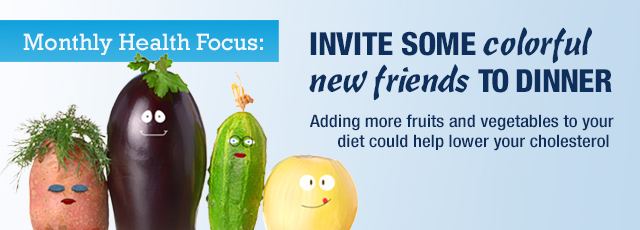Health Focus: Cholesterol Content (Sep '14)


The Right Foods May Help Lower Your Cholesterol
Half of all Americans have high cholesterol, putting them at risk for heart disease and stroke. Lifestyle changes to lower cholesterol may include eating foods low in saturated and trans fats, losing weight, if needed, and exercising 30 minutes or more on most days of the week.
Following the guidance in the MyPlate Plan can help lower your cholesterol. You can find the MyPlate Plan at www.choosemyplate.gov. It includes these suggestions for choosing foods low in cholesterol and total, saturated and trans fats:
Protein Foods:
- Limit meat intake to 6 ounces per day.
- Choose servings from fish, shellfish, poultry (with skin removed), low-fat lunchmeats, lean beef or pork, and beans.
- Eggs are higher in cholesterol, but low in saturated fat. Limit egg yolks to 3 per week (choosing egg whites more often).
- Avoid organ meats including liver, heart, chitlins and kidney.
- Bake, broil, roast, grill, microwave or stir-fry meats instead of frying. Trim away visible fat before cooking.
Breads, cereals, pasta and starchy vegetables:
- Six or more servings a day with 2 grams of fat or less per serving. Choose whole grains more often.
- Breads: serving is 1 slice or one half bun, bagel or muffin; choose from wheat, rye, or white bread, bagels, pita bread and corn tortillas.
- Crackers and snacks: serving is 1 oz.; choose from animal, graham, and saltine crackers, fig bars, ginger snaps, popcorn and pretzels.
- Hot or cold cereals: serving is one half cup hot, 1 oz. ready-to-eat cereal.
- Starchy vegetables: serving is one quarter to one half cup; choose from potatoes, corn, peas, lima beans, dried beans and sweet potatoes.
- Rice and pasta: serving is one half cup.
Milk and dairy:
- Three servings a day for most adults.
- Milk or buttermilk: serving is 1 cup; choose from skim, fat-free, and 1/2 - 1% low-fat milk, and non-fat or low-fat yogurt.
- Low-fat cheeses: serving is 1 ounce; choose from low-fat cottage cheese or other cheeses with no more than 3 grams of fat and 2 grams of saturated fat per oz.
- Non-fat or low-fat ice cream: choose items with no more than 3 grams of fat per half cup serving.
Fruits and vegetables
- Servings per day: five to nine. Make half your plate fruits and vegetables.
- A serving is equal to 1 medium piece of fruit, 1/2 cup of fruit or cooked vegetable, 1 cup raw vegetable, 6 oz. of vegetable juice or 100% fruit juice, or one quarter cup dried fruit.
- Season vegetables with herbs and spices instead of fat.
Fats and oils
- Use sparingly! Avoid animal sources of fat, shortenings, palm oil and coconut oil, which are high in saturated fat.
- Consume no more than five to eight servings a day.
- Serving size is equal to 1 tsp. vegetable oil or margarine, 2 tsp. diet margarine, 1 tbsp. salad dressing, 1 tbsp. seeds or nuts and 2 tsp. mayonnaise or peanut butter.
- Choose oils and margarines with liquid vegetable oil as the first ingredient and no more than two grams of saturated fat per tbsp. Examples are canola, corn, olive, safflower, soybean and sunflower oils.
- Avoid trans fats, which raise blood cholesterol levels and may increase risk of certain cancers. Trans fats are often found in processed baked goods such as cookies, crackers and cakes. The words "hydrogenated" or "partially hydrogenated" on the ingredient panel mean trans fats are present.
FYH-187 (Rev. 3-2012)
